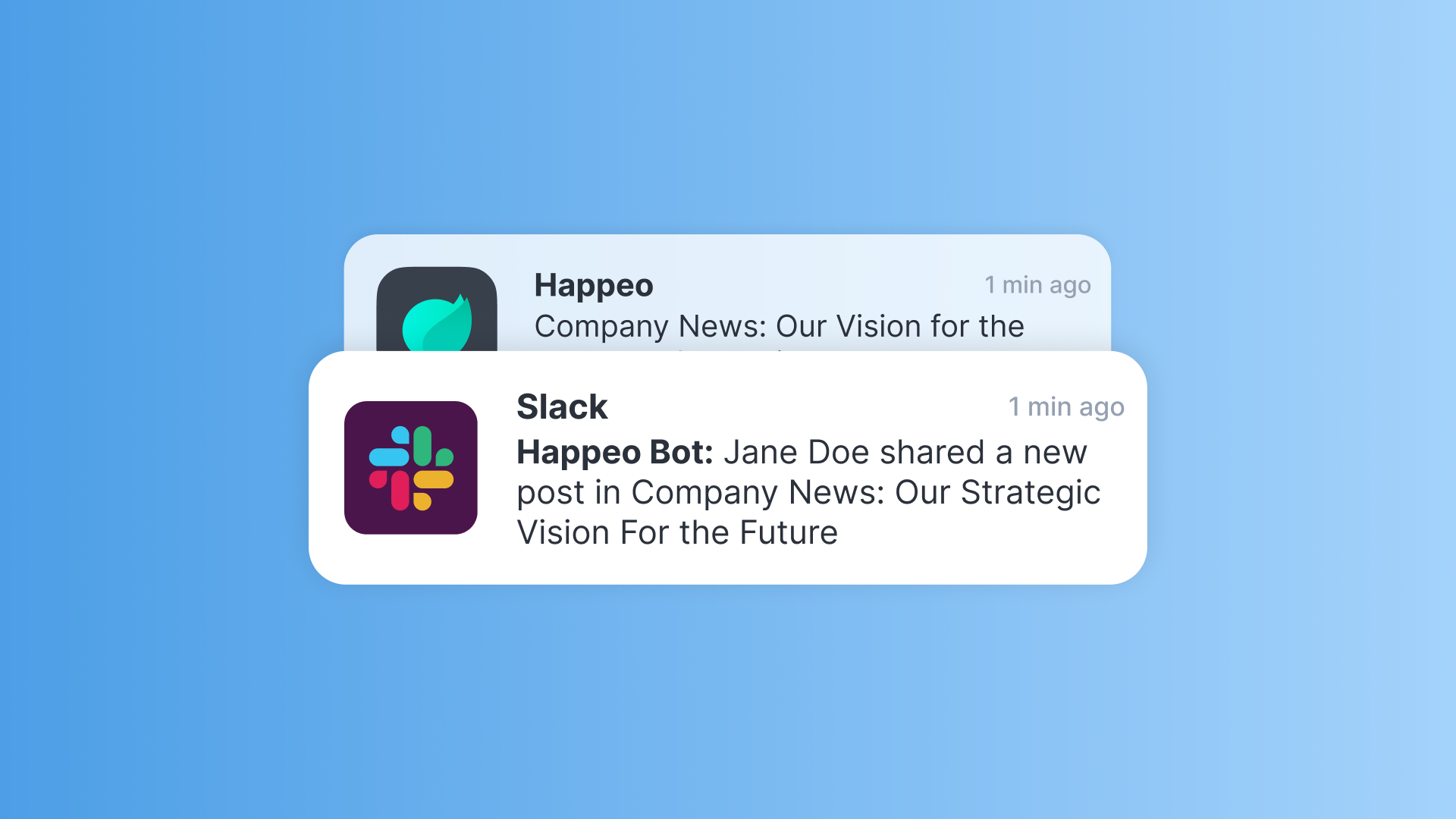

Jonathan Davies
11 mins read
Start building your digital home with Happeo
Request a demoIntranet software can work as a CMS, a communication tool, and much more. But how does that all come together, and what does it look like exactly?
As contributor Frank Hamm states in his article for Seibert Media, “an intranet is not a software program, but a platform for communication and collaboration with various components.” These different components are what come together to create one holistic intranet, centered around the intranet user.
In this post, we will dissect the essential components of an intranet and explain why they are essential, while also giving you twelve intranet features that are critical to the success of each working component.
Intranet components: understanding how it works
Now that you have a better understanding of what we actually mean when we refer to the intranet, let’s break it down for you. Since intranet is an overarching, all-inclusive term, we want to break down each major component to give examples as to how your intranet software will function in your workplace. There are many different intranet uses, but when they all come together, they create one unified, efficient digital workplace.
Content management system
Successful intranet software is going to completely streamline and upgrade your document management system. Intranets provide a centralized location for document and data storage that is easily managed and searchable for employees. Information can be stored and shared across the platform in an organized way, and employees can have access to important forms and information they need to do their jobs.
Gone are the days of outdated, irrelevant content on your intranet. With and easy to upload, store, and use platform for documents, information can stay relevant and helpful to employees.
Slideshows, spreadsheets, word documents, employee forms and handbooks can all be stored on the intranet and available to all who need access. You can keep old copies of updated documents, compile and share information, and empower employees to create their own content. If your document management system is well structured and organized, your employees should be able to access information and edit content with ease.
Internal Communications and social platform
Intranets are examples of effective ways to connect your employees across departments, time zones, and physical distances.
Each employee can create a personalized profile that lists their skills and projects, so with a high-quality search engine, employees can search for coworkers to chat, bounce off ideas, collaborate on assignments, and make new connections. Along with that, intranet software incorporates all your favorite reaction features of social media like comments, likes, and @mentions.
These communication intranet features shatter the old “top-down” communication system and gives all users access to instantaneous communication. Leadership can distribute important information to employees, and with the above-mentioned social features in place, employees can react and respond appropriately. Every users has an equal opportunity to communicate with each other, regardless of seniority or position. This goes beyond increasing productivity in the workplace to actually changing the culture. Employees will begin to see communication as a top priority to the company, and a culture of good, effective communication will blossom.
Digital collaboration
An intranet example of a well-organized CMS coupled with easy communication will deliver you a platform for huge collaborative efforts. With access to documents and information, plus connection to coworkers, your employees can digitally collaborate on any tasks or projects with ease. You can also create specific team workplaces designed around a topic, issue, or project where employees can have conversations or work on assignments all relevant to the issue at hand. These workplaces are centralized, efficient, searchable, and can be public or private.
Collaborating on a digital platform also allows team members in different locations to work and communicate with ease. Management can create teams and unite them simply based on skill or the project without having to consider outside factors. You can also coordinate calendars and task managers to keep a team focused and on track. Meanwhile, the real time editing, commenting, and content creation on shared documents in these designated workspaces provides a productive way for all employees to complete their tasks.
Integrated solution
If you are currently using multiple collaboration tools for your internal communications, you might be running into issues. Although there’s a plethora of options out there for SaaS tools, what those tools don’t do is talk to each other. They remain separate entities, which can create silos in your workplace. What an example of an integrated intranet does is take the functions and features of all of those separate tools and combines them into one fully integrated system. This way, it’s not a separate messaging tool from a separate management tool from a separate data storage tool. Everything you need is housed together under one roof, and every feature of the intranet integrates with the others.
Many different intranet softwares bring in those outside SaaS tools and integrate them into your intranet solution for a smoother adoption process and optimal working tools for your team.
When you can integrate all of your solutions in one centralized hub, you eliminate the time it takes for employees to continually switch platforms, which increases productivity too. That's what Happeo is here for.
12 critical intranet features
We’re going to break it down even further for you. Intranet components are the big picture ways that intranets function in your workplace, but there are specific intranet features that must be included to optimize those functions. Here, we are going to go through twelve different features of intranet software to give an example of what your intranet should include to provide the best solution possible.
1. Social capabilities
As we mentioned, transforming internal communication is fundamental to intranet software, and one of the ways this is accomplished is through strong social capabilities. The more opportunities your colleagues have to connect with one another in an efficient and productive way, the better your workplace will function. Example social intranet features include:
- A social portal homepage that provides a search of employee profiles and displays social media information
- Modern social features such as @mentions, comments, liking, etc.
- Integration with other social media tools already in use
- Easy to create and share multimedia content
- Mobile app inclusion and capability for continued connection
- Forums and conversation threads
2. Smart search
One of the main advantages of an intranet solution is having all company and employee information stored in the same unified platform, but without a powerful, intuitive search engine, the wealth of that information could be lost. Including a well-designed search engine is going to give you those productivity results you long for in an intranet by cutting back on the time it takes to find information and by aiding employees in finding the people they need to get the job done. Examples of intranet search engines should:
- Search through categories that have been “tagged” in content to give results
- Search through employee directory to find people associated with keywords, categories, or skills
- Search across the entire scope of the intranet (documents, files, slideshows, profiles, ect.)
- Sort results by listing the most relevant information first
3. Clean user-interface
Similar to a smart search engine, if you have a confusing user-interface, employees will not be able to access the content or data stored on your intranet. User-interface includes the aspects of your intranet that relate to its functionality, such as drop-down menus, layout, buttons, pages, ect. Not investing in a streamlined UI can be counterproductive, because employees will spend more time trying to figure out how to create or edit a document instead of dedicating that time to completing the task. Your example intranet UI should feature:
- Engaging and relevant homepage with personalized news feed
- Quick links on a menu or sidebar to all intranet features
- Notification alerts for conversations or upcoming tasks
- Search engine bar
- List of users currently online
- Easy way to post, share, or create
- Intuitive, streamlined, creative design
4. Content creation and management platform
The driving factor behind an intranet is that it is user-centric and it empowers the employees. One of the best ways to accomplish that is by giving them the space and freedom to create the content on your intranet. Your employees get to express themselves, and content stays relevant to the trends and issues that employees care about.
That said, you will want to educate your employees on how to create “good” content and what you want the style of the content to be. Give them the tools they need, appoint team members to manage the quality of content, and let them run with it. Examples of intranet content should be:
- User focused, generated, and managed
- Short, concise, engaging, and relevant
- Interactive for the reader (i.e. comments, liking, sharing)
- Uniform to the company and easy to create through a designated platform
- Tagged with keywords for searchability
- Organized within the intranet in a user-friendly manner
5. Personalization and customization
Intranet software now has the capability to learn from its users and let its users create the site they want to see. With so many personalization touches built-in such as unique profiles, tags to projects and skills, created or linked content, your intranet software should be able to pick up on what each individual user wants to see. It’s also important to have customizable intranet software so your employees can create the digital workspace that functions the best for them. Your intranet should:
- Allow for employee customization of homepages, shortcuts, and content organization
- Feature widgets that bring in specific content to an individual employee’s homepage from different areas of the intranet that are relevant
- Feature a widget that allows employees to dictate what they want to see more of
- Allow access to only specific users for sensitive or relevant content
6. Built-in employee feedback
In the digital workspace, employee satisfaction and experience are the main focus. We’re seeing a shift away from measuring intranet success with hard KPI statistics towards more qualitative, narrative feedback. This means your intranet software should have built-in employee comment/feedback options wherever and whenever possible. If you create an organized system to manage this continuous content, you should be able to address the issues of your employees and create the intranet that they want to use. Some intranet examples to build-in feedback are to:
- Include feedback features in company emails or messages, or link back to the full story on the intranet where employees can weigh in.
- Create forums for employees to voice their opinions on specific topics
- Conduct regular surveys which rate the employee satisfaction with intranet usability
- Put a management or organization system in place to track feedback and address it
7. Administration and task management
Effective intranet software empowers employees to become intranet administrators on a basic level, which helps alleviate the IT department’s workload while also sharing the responsibility of a healthy, successful intranet across your team. Choosing simple administrative tasks which can easily be delegated to employees will improve intranet function and upkeep as a whole. Along with administrative task management, employees should also have a project task management space to help them organize their current projects in a productive way. Task areas should:
- Provide links to the tools employees need to get the job done
- Include basic “how-to’s” for simple and uniform business procedures
- Include workflows or timelines
- Connect employees with other employees working on the same project
- Allow employee to customize the organization of their tasks
8. Innovative document and idea sharing
While employee communication is largely covered in the social tools of your intranet, it’s important to have designated space for employees to share ideas and relevant documents with each other. This goes beyond content creation into virtual brainstorming for your employees, which will help your intranet perform at its best. If you build in an area where employees can freely create and share ideas, it will encourage innovation, creative-thinking, and collaboration throughout the workplace. Examples of intranet ideation platforms should include:
- Space for employees to create and share original ideas freely
- Space for management to start conversations surrounding a topic or new product to spark brainstorming
- Tools to link and share documents pertaining to the topic
- Integration with document management for sharing purposes
9. Help center
Even with intuitive search and a well-designed UI, there are still going to be users who need help navigating the expansive system. Creating a help center will empower those employees to solve the issues themselves and learn by doing. This should be a general instruction area that gives users “how-to” guides while also helping to address specific issues in the intranet. An example intranet help center should include:
- FAQs, instructional videos, and user reviews to guide employees
- Chat feature where users can virtually chat with an IT member
- Comment section where users can leave tips and feedback
- Organized pages and content sorted by categories
10. Mobile app and anywhere access
This is now a must-have in intranet software. Intranets are meant to jump your enterprise into the digital age by connecting employees across the globe – wherever they are, whatever they are doing. Including a mobile app with your intranet solution gives users “on-the-go” capabilities, so they can stay connected on tasks and work conversations at all times. This also allows you to send push notifications to make sure employees are seeing any crucial updates or information. Your mobile app should provide:
- Full access to the intranet system from your employee’s mobile device
- User-friendly, responsive interface
- Notifications that are sent to mobile devices from management to update employees 24/7
- Integration with other mobile apps and software
11. Reinforce culture
While this isn’t necessarily a production “tool” for users, it is one of the essential roles that intranets play in the workplace. Intranets allow you to internally brand your company and educate your employees on the mission, vision, goals, and values you have. Intranet branding unites employees and gives them an aim to work towards daily. It provides a sense of belonging to a bigger picture, and when you can create a culture centered around the employee experience, your workplace will flourish. Some examples in using the intranet reinforcing the culture are:
- Using visual elements in your UI that further brands or reinforces company vision
- Creating standards or guidelines for content that uphold company values
- Make sure senior staff and leadership team set the example to reinforce company culture
- Working to connect and unite staff through employee recognition, outside-the-office activities, and a focus on fostering internal relationships
12. Project or team workspaces
Team workspaces go hand-in-hand with idea sharing and task management, but it is important to put emphasis on the specific dedication of collaboration spaces for teams.
You can have specific department workspaces, team workspaces organized around a specific project, or topic workspaces where employees who are working on separate projects around the same theme can share ideas. You can even create workspaces to unite employees who are all attending the same event or who help facilitate a location move. A good team workspace should:
- Be searchable, collaborative, and have ability to be public or private
- Allow users to guide content and conversation with full document sharing and content creation capabilities
- Be fully self-serviced by the specific group
- Give access to necessary information via links or integration



